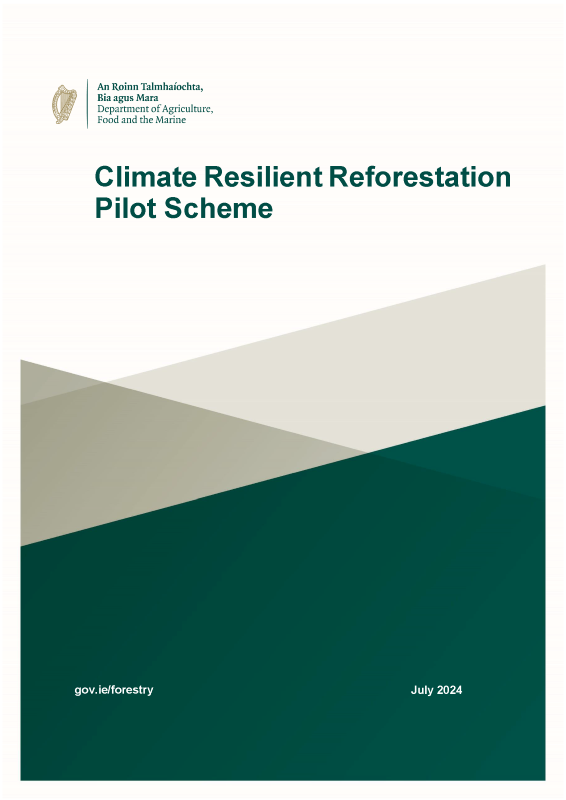The Climate Resilient Reforestation Scheme (CRR) is designed to enhance the climate resilience of forests in Ireland by encouraging forest owners to adopt diverse and sustainable management practices during reforestation. It provides financial support for three distinct reforestation approaches: Continuous Cover Forestry, Native Forests, and Biodiversity and Water protection. The Minister of State for Land Use and Biodiversity at the Department of Agriculture, Food and the Marine, Senator Pippa Hackett, launched the scheme on July 24th 2024. The scheme is open for applications under the Forestry Programme 2023-2027. This Scheme provides a range of options to support forest owners considering a move to close-to-nature forest management at the reforestation stage. These options are arranged under three elements, which you can see in the extract below and where you can also download the full guideline document.
Extract

“The overall objective of this Scheme is to increase the climate resilience of the national forest estate by expanding the proportion of forest land managed under permanent forest cover using close to nature silviculture. This aligns with one of the three objectives under the Forest Strategy, which looks for the ‘rapid and sustainable expansion of climate resilient and biodiverse forests that support a healthy and high-quality environment’. This Scheme provides a range of options to support forest owners considering a move to close to nature forest management at reforestation stage. These options are arranged under three elements, as described below. An individual application under this Scheme can apply under one, two or all three elements (as long as no physical overlap exists and one element is selected per plot).
Element 1: Reforestation for Continuous Cover Forestry (CCF):
Encourages the design and layout of the replacement forest in a manner that facilitates the future realisation of quality wood products using established CCF principles and practices.
Element 2: Reforestation for Native Forests:
Encourages the replacement, at reforestation stage, of existing conifer stands with the most appropriate native forest type or types for the site, using the Native Forest Framework (contained in the Forestry Standards Manual – Appendix 2 on page 144) and the various scenarios described therein. (Note, such projects were previously funded under the last Forestry Programme, under the Native Woodland Conservation Scheme.) The resulting native forest is permanent in nature and may be managed for quality wood products using established CCF principles and practices, where compatible with the ongoing development of the native woodland and its associated ecosystem.
Element 3: Reforestation for Biodiversity and Water:
Encourages the creation of undisturbed areas for biodiversity and water protection, typically in areas adjoining the water setback required at reforestation stage. Associated measures including drain-blocking, slow-water damming and the planting of native broadleaves, either widely spaced or as groups. This element aims to create a permanent semi-natural zone that will provide further protection to water and enhance biodiversity throughout the second rotation and beyond. (Note, Element 3 reflects the Biodiversity & Water (‘Bio’) Reforestation Objective set out in DAFM’s Felling & Reforestation Policy.)”
Downloads
Download the full document from the Forest Service of DAFM website – Click to Download the links below:
Publications and Resources:
The Climate Resilient Reforestation Scheme document should be read in conjunction with:
I. The Forestry Standards Manual, Standards for Felling & Reforestation, the Felling & Reforestation Policy document, and various scheme circulars can be downloaded from the Department’s website at: www.gov.ie/forestry
II. Certain standards applicable under the Native Woodland Conservation Scheme, as set out in the Native Woodland Conservation Scheme document;
III. DAFM’s Native Forest Framework document (in relation to CRR Element 2), as contained in the Forestry Standards Manual (Appendix 2 on page 144);
IV. Any/all circulars amending the requirements of this Climate Resilient Reforestation Pilot Scheme that are periodically issued by DAFM.
Native Woodland Conservation Scheme Training
Native Woodland Training Courses are held periodically by the Forest Service of DAFM in association with Woodlands of Ireland for landowners, stakeholders (i.e. statutory agency staff, nursery owners, environmental NGOs and interested individuals) and Native Woodland Conservation Scheme (NWC) practitioners (i.e. foresters, ecologists and woodland contractors). Training can entail 2-day courses that encompass a broad range of management, ecological and silvicultural topics specific to Native Woodland Conservation. The 2-day course is also a requirement for NWC foresters and ecologists to attend in order to receive accreditation to work on the NWC contracts. Please see an updated directory of registered DAFM approved Foresters and Ecologists, note the foresters that are eligible to work on NWC contracts have a box ticked on the available registered list from DAFM. (Woodlands of Ireland will endeavor to keep these list links updated) Please see Native Woodland Information Notes as supporting literature to the NWC.
If you would like to be added to the waiting list for upcoming NWC training courses, please email info@woodlandsofireland.com with your name, location and contact number.